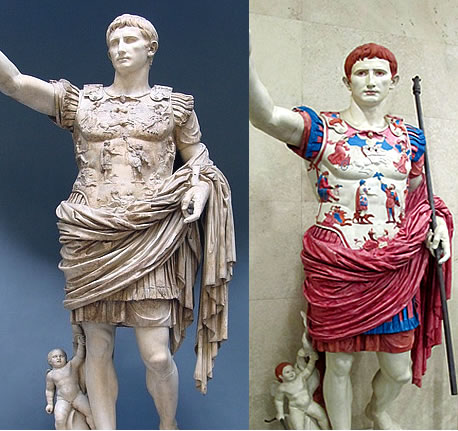The colorful statues

The German archaeologist and erudite Johann Winckelmann in the second half of the eighteenth century claimed that the statues of the great Greek and Roman masters had to be white, because white was the perfect color that included all the others. From this statement it was born a peculiar misunderstanding that lasted almost two centuries, everyone, academics, researchers and art lovers were convinced that the Greek and Roman statues were strictly white.
But, at the end of '700, there were cases in which it went even further and Greek and Roman statues that showed the presence of coloring were subjected to careful "smoothing compound with acid" to bring them back to the supposed original whiteness.
Not all historians and critics were, however, agree with Winckelmann, in fact, the French archaeologist and erudite Antoine Chrysostome Quatremère de Quincy argued that in the statues the color had been used always and quoted also evidence of ancient sources such as Pliny the Elder , Pseudo-Aristotle, Theophrastus and Vitruvius (Book VII), which also provided detailed descriptions of the raw materials, processes for the preparation and also on prices.
At the end of the nineteenth century in Germany they began early research to test the theory of colored statues but only the new techniques with the use of ultraviolet and infrared managed to reveal so conclusively the presence of colored pigments.
A statue that revealed unexpected features is that of Augustus found in the Villa of Livia at Prima Porta that at the time of the discovery in 1886 had obvious traces of color that induced Ludwig Fenger in attempting a graphic reconstruction; with the passage of time due to exposure to light the colors faded and also the interest in the colorfulness of the statue.
During a recent restoration carried out in the Laboratory of the Vatican Museums The statue was photographed in ultraviolet light and it was possible to see color presence, not visible to the naked eye; In fact, the color has different light frequencies both from the marble and by calcareous deposits from or by the chalk fillings which are of turned blue.
I colori sono stati trovati sulle vesti, sui dettagli della corazza, sui capelli e sui dettagli degli occhi, ma non sulla pelle, né sul fondo della corazza che mantenevano il colore e la trasparenza del marmo di Paros. The many traces found on the marble made it possible to reconstruct the color of the coat that was red and made not with ocher earth but with plant pigments, in the garanza lacquer, extracted from the roots of madder; this pigment did not cover the shine of white marble and conferred on the whole an extraordinary brilliance.
But in reality the colors used are more, six or seven; from frit Alexandrian or Egyptian blue used for the mantle of Heaven on the armor, for the metallic elements such as the chariot of the Sun rotates, and the harness of the horses, a part of pteryges of Mars armor and his helmet, for a portion of the leather straps of armor of Augustus and other; the red of garanza lacquer that colors, beyond the emperor's coat, a part of the same strips of sometimes mixed with carmine, leather and clothing of celebrities on the breastplate; a red made from ocher to the emperor's robe and lips (the "lipstick"); a brown "Sienna earth" for leather harnesses of the horses of the chariot of the Sun, whose shoes of Mars, the Roman insignia, while a light brown was used for all of the hair, of Emperor and of characters on the armor finally the yellow (lead oxides) only on the fringes ...
Sign up and read the rest of the article!
by M.L. ©ALL RIGHTS RESERVED (Ed 1.0 - 29/08/2016)






